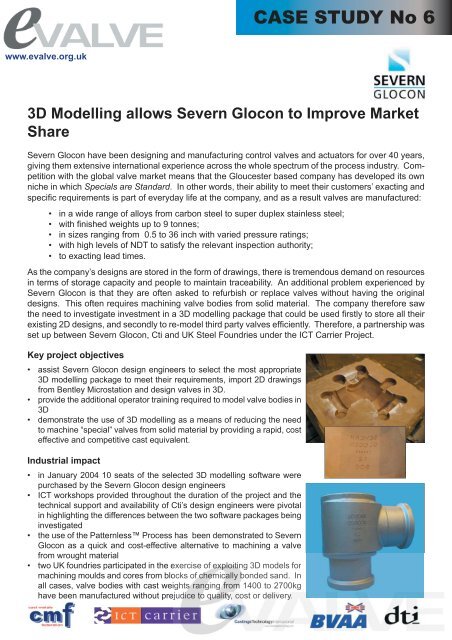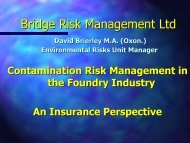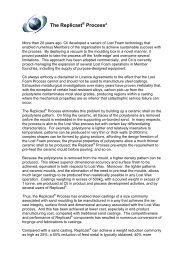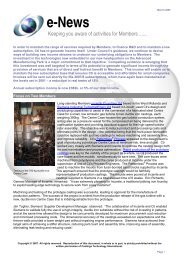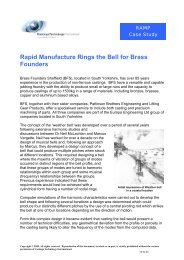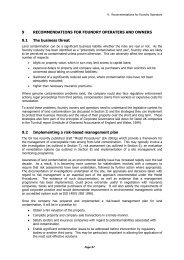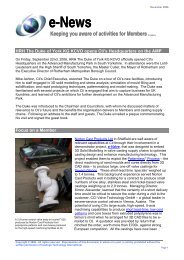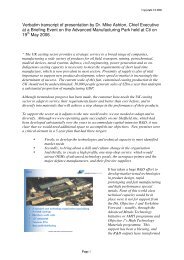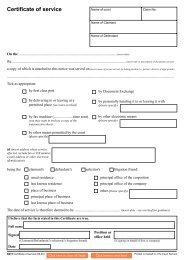3D Modelling allows Severn Glocon to Improve Market - Castings ...
3D Modelling allows Severn Glocon to Improve Market - Castings ...
3D Modelling allows Severn Glocon to Improve Market - Castings ...
You also want an ePaper? Increase the reach of your titles
YUMPU automatically turns print PDFs into web optimized ePapers that Google loves.
CASE STUDY No 6<br />
www.evalve.org.uk<br />
www.evalve.org.uk<br />
<strong>3D</strong> <strong>Modelling</strong> <strong>allows</strong> <strong>Severn</strong> <strong>Glocon</strong> <strong>to</strong> <strong>Improve</strong> <strong>Market</strong><br />
Share<br />
<strong>Severn</strong> <strong>Glocon</strong> have been designing and manufacturing control valves and actua<strong>to</strong>rs for over 40 years,<br />
giving them extensive international experience across the whole spectrum of the process industry. Competition<br />
with the global valve market means that the Gloucester based company has developed its own<br />
niche in which Specials are Standard. In other words, their ability <strong>to</strong> meet their cus<strong>to</strong>mers’ exacting and<br />
specifi c requirements is part of everyday life at the company, and as a result valves are manufactured:<br />
• in a wide range of alloys from carbon steel <strong>to</strong> super duplex stainless steel;<br />
• with fi nished weights up <strong>to</strong> 9 <strong>to</strong>nnes;<br />
• in sizes ranging from 0.5 <strong>to</strong> 36 inch with varied pressure ratings;<br />
• with high levels of NDT <strong>to</strong> satisfy the relevant inspection authority;<br />
• <strong>to</strong> exacting lead times.<br />
As the company’s designs are s<strong>to</strong>red in the form of drawings, there is tremendous demand on resources<br />
in terms of s<strong>to</strong>rage capacity and people <strong>to</strong> maintain traceability. An additional problem experienced by<br />
<strong>Severn</strong> <strong>Glocon</strong> is that they are often asked <strong>to</strong> refurbish or replace valves without having the original<br />
designs. This often requires machining valve bodies from solid material. The company therefore saw<br />
the need <strong>to</strong> investigate investment in a <strong>3D</strong> modelling package that could be used fi rstly <strong>to</strong> s<strong>to</strong>re all their<br />
existing 2D designs, and secondly <strong>to</strong> re-model third party valves effi ciently. Therefore, a partnership was<br />
set up between <strong>Severn</strong> <strong>Glocon</strong>, Cti and UK Steel Foundries under the ICT Carrier Project.<br />
Key project objectives<br />
• assist <strong>Severn</strong> <strong>Glocon</strong> design engineers <strong>to</strong> select the most appropriate<br />
<strong>3D</strong> modelling package <strong>to</strong> meet their requirements, import 2D drawings<br />
from Bentley Microstation and design valves in <strong>3D</strong>.<br />
• provide the additional opera<strong>to</strong>r training required <strong>to</strong> model valve bodies in<br />
<strong>3D</strong><br />
• demonstrate the use of <strong>3D</strong> modelling as a means of reducing the need<br />
<strong>to</strong> machine “special” valves from solid material by providing a rapid, cost<br />
effective and competitive cast equivalent.<br />
Industrial impact<br />
• in January 2004 10 seats of the selected <strong>3D</strong> modelling software were<br />
purchased by the <strong>Severn</strong> <strong>Glocon</strong> design engineers<br />
• ICT workshops provided throughout the duration of the project and the<br />
technical support and availability of Cti’s design engineers were pivotal<br />
in highlighting the differences between the two software packages being<br />
investigated<br />
• the use of the Patternless Process has been demonstrated <strong>to</strong> <strong>Severn</strong><br />
<strong>Glocon</strong> as a quick and cost-effective alternative <strong>to</strong> machining a valve<br />
from wrought material<br />
• two UK foundries participated in the exercise of exploiting <strong>3D</strong> models for<br />
machining moulds and cores from blocks of chemically bonded sand. In<br />
all cases, valve bodies with cast weights ranging from 1400 <strong>to</strong> 2700kg<br />
have been manufactured without prejudice <strong>to</strong> quality, cost or delivery.
Why was this work necessary?<br />
<strong>Severn</strong> <strong>Glocon</strong> is an experienced manufacturer of valves<br />
and actua<strong>to</strong>rs, and their cus<strong>to</strong>mers demand a wide range<br />
of products, <strong>to</strong> such an extent that Specials are Standard.<br />
Valves are produced in a wide range of materials, sizes,<br />
fi nished weights, <strong>to</strong> high levels of NDT and <strong>to</strong> exacting<br />
lead times.<br />
Foundry selection is largely determined by the alloys and<br />
casting weights available, and virtually all of the valve<br />
bodies purchased are manufactured from traditional pattern<br />
equipment using the sand casting process. Traditional<br />
pattern equipment is modifi ed <strong>to</strong> meet changes <strong>to</strong><br />
design requirements, the designs for which are based<br />
on 2D drawings that occupy a vast fl oor area and require<br />
several people <strong>to</strong> maintain traceability.<br />
The refurbishment or replacement of third party valves<br />
can also pose a problem. <strong>Severn</strong> <strong>Glocon</strong> may not have<br />
access <strong>to</strong> the original pattern equipment or an equivalent,<br />
which can be rapidly modifi ed <strong>to</strong> meet the engineering criteria.<br />
The company typically machines the valve internal<br />
shape from forged material - a costly and time consuming<br />
process. As a result, the company has been searching<br />
for an alternative method <strong>to</strong> eliminate the numerous manhours<br />
spent machining the valve from solid. These two issues<br />
of replacing 2D drawings and machining valves from<br />
forgings formed the focus of the joint ICT Carrier Project<br />
between <strong>Severn</strong> <strong>Glocon</strong>, Cti and UK Steel Foundries.<br />
Key steps on the road <strong>to</strong> success<br />
For the introduction of <strong>3D</strong> modelling <strong>to</strong> a traditional valve<br />
company <strong>to</strong> be successful, a number of key points need<br />
<strong>to</strong> be recognised. These points, based upon the experiences<br />
of <strong>Severn</strong> <strong>Glocon</strong>, include:<br />
• a commitment <strong>to</strong> the initiative at all levels of management<br />
and the recognition that the introduction of <strong>3D</strong><br />
modelling will take both time and money <strong>to</strong> appreciate<br />
its full potential<br />
• the individuals within the company selected <strong>to</strong> implement<br />
or evaluate this new concept of working need <strong>to</strong><br />
be adequately skilled, ‘open-minded’ and receptive <strong>to</strong><br />
change<br />
• a realisation that the introduction of the technology will<br />
‘add value’ <strong>to</strong> the business by improving <strong>to</strong>tal cost reduction,<br />
effi ciency and productivity<br />
• knowledge that the benefi ts of the technology can be<br />
measured, accepted and unders<strong>to</strong>od by the manufacturing<br />
management<br />
• the selection of the software package is based upon<br />
real experiences rather than ‘perception’<br />
• a requirement <strong>to</strong> obtain impartial technical support<br />
from a bona-fi de third party rather than the sole reliance<br />
of the software vendor<br />
• ensuring that the supply chain is capable of exploiting<br />
<strong>3D</strong> data <strong>to</strong> its maximum potential<br />
• patience is required.<br />
Exploiting <strong>3D</strong> models for rapid pro<strong>to</strong>typing within<br />
the valve and other manufacturing sec<strong>to</strong>rs<br />
The significance of a rapid pro<strong>to</strong>type is clearly one of defi -<br />
nition. In this exemplar we consider a maximum fi nished<br />
casting weight of the pro<strong>to</strong>type of 1420kg. The use of<br />
<strong>3D</strong> models opens the mind <strong>to</strong> opportunities for increasing<br />
the pro<strong>to</strong>typing envelope in terms of dimension and, as a<br />
result, mass. The use of the Patternless Process at this<br />
time is only restricted by the capacity of the CNC milling<br />
machine currently available at Cti. Therefore, the upper<br />
limit in terms of mass has yet <strong>to</strong> be determined.<br />
A <strong>3D</strong> model of a valve is used <strong>to</strong> create the cutter path<br />
data for milling of sand blocks. The Patternless Process<br />
can be applied regardless of valve size. In fact, the<br />
larger the valve the more cost-effective the technology<br />
becomes. Two limiting fac<strong>to</strong>rs exist, the size of the sandmilling<br />
machine and foundry melting capacity. This latter<br />
constraint is overcome by transporting the moulds <strong>to</strong> the<br />
host foundry for pouring and finishing.<br />
The positive results from the use of this technology has<br />
prompted industrialists within the donor sec<strong>to</strong>r <strong>to</strong> make<br />
the following comments:<br />
“The casting was delivered ahead of schedule and was<br />
processed without problem, further confirming <strong>Severn</strong> <strong>Glocon</strong>’s<br />
faith in the Patternless Process” – Alan Homfray,<br />
Technical and Commercial Manager of <strong>Severn</strong> <strong>Glocon</strong>.<br />
“It was a beautiful casting with an excellent casting surface<br />
finish, proving that the technology works and can’t<br />
be faulted”. – Ian Furniss, Managing Direc<strong>to</strong>r of Furniss<br />
& White.<br />
“The casting surface finish and integrity was excellent<br />
and exceeded the client’s specifi ed quality requirements”.<br />
– Simon Alexander, Managing Direc<strong>to</strong>r of Nor<strong>to</strong>n Cast<br />
Products Ltd.<br />
Whilst the Patternless Process has been focused upon<br />
the Valve and Marine market sec<strong>to</strong>rs, it is clearly applicable<br />
<strong>to</strong> other manufacturing sec<strong>to</strong>rs requiring rapid pro<strong>to</strong>types<br />
of large mass, with exacting delivery requirements<br />
and where quality and accuracy are critical. The use of<br />
this UK developed technology provides both casting users<br />
and producers with a unique chance of exploiting a market<br />
need and thereby securing new markets opportunities.<br />
Case Study prepared by <strong>Castings</strong> Technology International,<br />
7 East Bank Road, Sheffield, S2 3PT, UK.<br />
Tel +44 (0)114 272 8647 Fax +44 (0)114 273 0852<br />
info@castingstechnology.com www.castingstechnology.com<br />
Case Study<br />
1<br />
Case Study<br />
2<br />
Case Study<br />
3<br />
Case Study<br />
4<br />
Case Study<br />
5<br />
Case Study<br />
6<br />
Case Study<br />
7<br />
Case Study<br />
8


